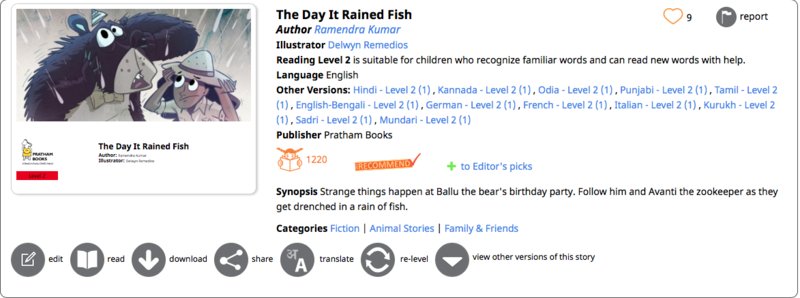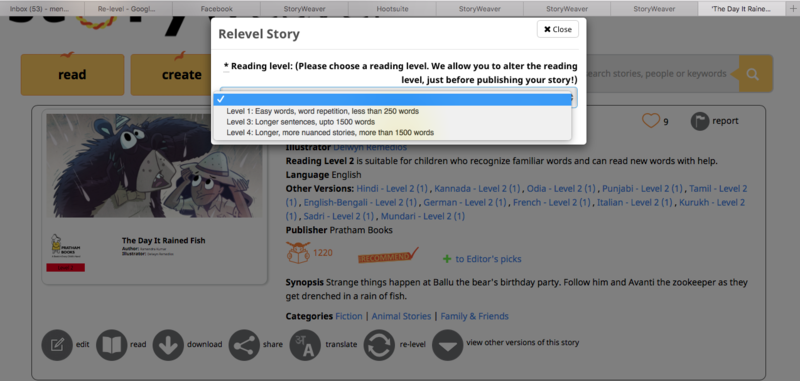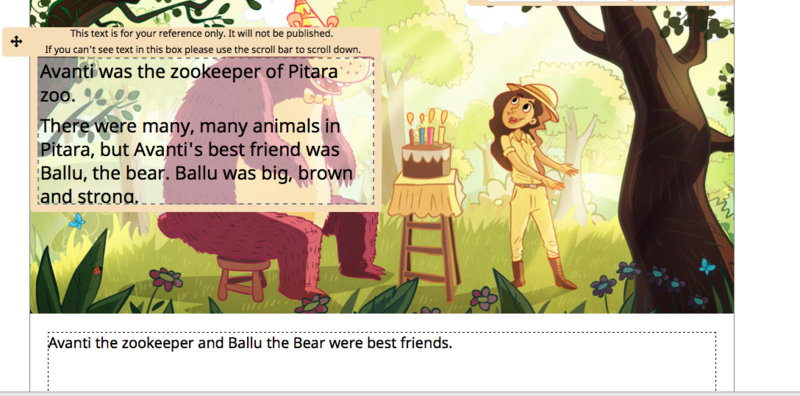ಬರಹ: ಹೇಮಾ ಡಿ.ಖುರ್ಸಾಪುರ
Posted by Remya Padmadas on September 30, 2017September 30th is celebrated around the world as International Translation Day. We're very fortunate that some of our wonderful translators and language reviewers shared their thoughts on translation and children's books with us on this occasion.
A travel freak who enjoys playing with words, Hema D Khursapur interests are movies, spirituality, Kannada, Hindi, Persian languages but not limited to them. She is a contemporary writer whose words were always a magic for language lovers.
In this blog post, she writes about what it means to imagine a story and then deliver it.
ಅನುವಾದ ಭಾವಾನುವಾದರೆ ಸಾರ್ಥಕ
ನರಭಕ್ಷಕ ಚಿರತೆ, ಹುಲಿ ಬೇಟೆ, ಶಿಕಾರಿ ಕುರಿತಾಗಿ ಕೆನೆತ್ ಆಂಡರ್ಸನ್ ಅವರು ಇಂಗ್ಲಿಷ್ನಲ್ಲಿ ಬರೆದ ಕತೆಗಳನ್ನು ಕೆ.ಪಿ.ಪೂರ್ಣಚಂದ್ರ ತೇಜಸ್ವಿ ಅವರು ‘ಕಾಡಿನ ಕತೆಗಳು’ ಎಂದು ಭಾವಾನುವಾದ ಮಾಡಿದ್ದಾರೆ. ಅದು ಅನುವಾದವಾಗದೆ ಭಾವಾನುವಾದ ಆದದ್ದು ಹೇಗೆ ಎಂದು ಪುಸ್ತಕದ ಮುನ್ನುಡಿಯಲ್ಲಿ ಹೀಗೆ ಬರೆಯುತ್ತಾರೆ.‘‘ ನಾನು ಹುಟ್ಟುವ ವೇಳೆಗಾಗಲೇ ಈ ಶಿಕಾರಿ ಯುಗದ ಕೊಟ್ಟ ಕೊನೆಯ ತುದಿ ಬಂದಿತ್ತು. ಆದರೂ ಈ ಕತೆಗಳನ್ನು ಅನುಭವಿಸಿ ಆಸ್ವಾದಿಸುವ ಮಟ್ಟಿಗಾದರೂ ನನಗೆ ಕಾಡಿನ ಅನುಭವಗಳ ಪರಿಚಯವಾಯ್ತು. ಕೆನೆತ್ ಆಂಡರ್ಸನ್ನರ ಕತೆಗಳ ಹಿನ್ನೆಲೆ ಪರಿಸರ, ಪಾತ್ರಗಳು ಎಲ್ಲ ನನಗೆ ನನ್ನ ಅನುಭವವೇ ಎನ್ನುವಷ್ಟು ಚಿರಪರಿಚಯ. ಚೋರ್ಡಿ. ಬೆಳ್ಳಂದೂರ, ಪಿಕಾರಿಪುರ, ಶೆಟ್ಟಿಹಳ್ಳಿ ನಾವು ಓಡಾಡಿದ, ಆ ಕಾಡುಗಳಲ್ಲಿ ಲಾಟರಿ ಹೊಡೆದ ಜಾಗಗಳು. ನಾವು ಕಾಡು ತಿರುಗಲಾರಂಭಿಸಿದಾಗ ನರಭಕ್ಷಕಗಳ ಯುಗ ಮುಗಿದಿತ್ತೆನ್ನುವುದೊಂದನ್ನು ಬಿಟ್ಟರೆ ಮಿಕ್ಕಿದ್ದೆಲ್ಲ ನಾನೇ ಆಂಡರ್ಸನ್ನರ ಜೊತೆ ಇದ್ದೆನೇನೋ ಎನ್ನುವಷ್ಟು ನನಗೆ ಗೊತ್ತು.
ತರ್ಜುಮೆ ಮಾಡ ಹೋದಾಗ ಇದರಿಂದ ನನಗಾದ ತೊಂದರೆ ಎಂದರೆ ಆಂಡರ್ಸನ್ನರ ಹೆಸರಿನಲ್ಲಿ ನನ್ನ ಅನುಭವಗಳು, ವಿವರಗಳು ಸೇರತೊಡಗಿದವು. ಹೀಗಾದ್ದರಿಂದಲೇ ಈ ತರ್ಜುಮೆಗಳನ್ನು ಭಾವಾನುವಾದ ಎಂದ ಕರೆಯಬೇಕಾದ ಅನಿವಾರ್ಯತೆ ಉಂಟಾಯ್ತು. ಈ ಕಥೆಗಳಲ್ಲಿ ಆಂಡರ್ಸನ್ನರ ಮೂಲಕಥೆಗಳ ಅಂತಃಸ್ಸತ್ವಕ್ಕೆ ತಿಲಮಾತ್ರವೂ ಚ್ಯುತಿ ಬರದಹಾಗೆ ಇಲ್ಲಿ ಪ್ರತಿನಿಧಿಸಿದ್ದೇನೆನ್ನುವುದೊಂದೇ ನನಗೆ ಸಮಾಧಾನದ ವಿಷಯ. ಮಕ್ಕೀಕಾಮಕ್ಕಿ ತರ್ಜುಮೆಗಿಂತ ಈ ರೀತಿ ಆಂಡರ್ಸನ್ನ ರನ್ನು ಪ್ರತಿನಿಧಿಸುವುದೇ ಆಂಡರ್ಸನ್ನರಿಗೆ ಹೆಚ್ಚು ನ್ಯಾಯ ದೊರಕಿಸಿದಂತೆ ಎಂದು ನಾನು ತಿಳಿದಿದ್ದೇನೆ,’’ ಎಂದು.
ಮೇಲಿನ ಸಾಲುಗಳನ್ನು ಓದುವಾಗ ಅನುವಾದ ಮೂಲ ಕೃತಿ ರಚನೆಗಿಂತ ಸೃಜನಶೀಲವಾದದ್ದು ಎಂದು ಅರ್ಥವಾಗುತ್ತದೆ. ಇದು ನನಗೆ ಅರ್ಥವಾಗಿದ್ದು, ದಿನಪತ್ರಿಕೆಯೊಂದರ ಸಾಪ್ತಾಹಿಕಕ್ಕೆ ಮಕ್ಕಳಿಗಾಗಿ ಪುಟವೊಂದನ್ನು ನಿರ್ವಹಿಸುತ್ತಿದಾಗ. ಮೊಸಳೆ ಕುರಿತಾದ ಅನುವಾದ ಭಾವಾನುವಾದದ್ದು ಅದರಲ್ಲಿ ಬಾಲ್ಯದ ನನ್ನ ಅನುಭವವೂ ಸೇರಿದ್ದರಿಂದ. 'Why crocodiles are best parents in the world'
ಭಾಗವನ್ನು ಅನುವಾದಿಸುವಾಗ ಚಿಕ್ಕಂದಿನಲ್ಲಿ ನದಿ ತೀರದಲ್ಲಿ ಅಸಹ್ಯವಾಗಿ ಬಾಯಿ ತೆರೆದು ಬಿದ್ದಿರುತ್ತಿದ್ದ ಮೊಸಳೆಗಳನ್ನು ದಿನವೂ ನೋಡುತ್ತಿದ್ದ ನನಗೆ ಅವುಗಳ ಬಗ್ಗೆ ಅಷ್ಟೇನೂ ಅಪ್ತತೆ ಇರಲಿಲ್ಲ. ಆದರೆ ಅವು ತಮ್ಮ ಮರಿಗಳಿಗೆ ಸ್ನಾನ ಮಾಡಿಸುವುದನ್ನು ನೋಡಿದಾಗ ಆವತ್ತಿಗೆ ನನ್ನಲ್ಲಿ ಮೂಡಿದ ಭಾವನೆಗಳನ್ನು ಅಕ್ಷರಗಳಲ್ಲಿ ಹಿಡಿದಿಡುವುದು ಸಾಧ್ಯವಿರಲಿಲ್ಲ. ಆ ಘಟನೆಯ ನಂತರ ಇಪ್ಪತ್ತು ವರ್ಷಗಳ ನಂತರ ನಾನು, ‘‘ಮೊಸಳೆಗಳು ಜಗತ್ತಿನ ಶ್ರೇಷ್ಠ ಅಪ್ಪ-ಅಮ್ಮ’’ ಬರಹದಲ್ಲಿ ಅವನ್ನು ಬರೆದಿದ್ದು ಹೀಗೆ. "ಮಕ್ಕಳು ದೊಡ್ಡ ತಪ್ಪು ಮಾಡಿ ಹ್ಯಾಪು ಮೋರೆ ಹಾಕಿಕೊಂಡು, ಕಣ್ಣೀರು ಸುರಿಸುತ್ತಾ ಅಪ್ಪ-ಅಮ್ಮ ನಮ್ಮನ್ನು ಹೊಡೆಯದಿದ್ದರೆ ಸಾಕು ಎಂದು ಗದರುವು ಮುನ್ನವೇ ಗೋಳೋ ಎನ್ನುತ್ತಿದ್ದರೆ, ಪ್ರತಿ ತಂದೆ-ತಾಯಿ ಜೀವಮಾನದಲ್ಲಿ ಒಮ್ಮೆಯಾದರೂ ಇಂತಹ ಮಕ್ಕಳಿಗೆ ಬೈದಿರುತ್ತಾರೆ ಸಾಕು ನಿಲ್ಲಿಸು ನಿನ್ನ ಈ ಮೊಸಳೆ ಕಣ್ಣೀರನ್ನು ಎಂದು. ಅಂದರೆ ಮೊಸಳೆ ಕಣ್ಣೀರು ಸುರಿಸುವುದು ನೋವಿನಿಂದ, ಬೇಜಾರಿನಿಂದ ಅಲ್ಲ. ಮೊಸಳೆಯ ಭಾವನೆಗಳಿಗೂ ಕಣ್ಣೀರಿಗೂ ಸಂಬಂಧವಿಲ್ಲ. ಆದರೂ ‘ಮೊಸಳೆ ಕಣ್ಣೀರು’ ನುಡಿಗಟ್ಟಾಗಿ ಬಳಕೆಯಲ್ಲಿದೆ. ಮೊಸಳೆಗಳು ಬಹುಕಾಲ ನೀರಿನಿಂದ ಮೇಲೆ ಇದ್ದಾಗ ಕಣ್ಣೀರು ಹಾಕುತ್ತವೆ. ಕಣ್ಣ ಪಾಪೆಗಳು ಒಣಗದಂತೆ ಮಾಡಲು ಗ್ರಂಥಿಗಳು ನೀರನ್ನು ಸುರಿಸುತ್ತವೆ ಮತ್ತು ನೀರಿನಿಂದ ಹೊರಗಿದ್ದಾಗ ಆಹಾರ ತಿನ್ನುವಾಗಲೂ ಮೊಸಳೆ ಕಣ್ಣುಗಳಿಂದ ನೀರು ಸುರಿಯುತ್ತದೆ. ಇದಕ್ಕೆ ಕಣ್ಣಿನ ರಕ್ಷಣೆ, ಆಹಾರ ಸೇವಿಸುವಾಗ ಉಂಟಾಗುವ ಒತ್ತಡ ಮೊದಲಾದವು ಕಾರಣಗಳಾಗಿರಬಹುದು ಎಂದು ವಿಜ್ಞಾನಿಗಳು ಅಭಿಪ್ರಾಯ ಪಡುತ್ತಾರೆ. ಎಲ್ಲ ಮೊಸಳೆಗಳು ಒಂದು ರೀತಿ ಅಡಾವುಡಿ ಮಾಡಿ ಸುಳ್ಳೇ ಸುಳ್ಳು ಕಣ್ಣೀರು ಸುರಿಸುವ ಮಕ್ಕಳಂತಾದರೆ, ತಮ್ಮ-ತಮ್ಮ ಮಕ್ಕಳು ವಿಷಯದಲ್ಲಿ ಅಪ್ಪ-ಅಮ್ಮ ಮೊಸಳೆಗಳು ಮಾತ್ರ ತುಂಬಾ ಅಂದ್ರೆ ತುಂಬಾ ಒಳ್ಳೆಯವು. ಮೊಸಳೆಗಳು ನೋಡಲು ಭಯಾನಕವಾಗಿದ್ದರೂ ತಮ್ಮ ಮಕ್ಕಳ ಜತೆ ತುಂಬಾ ಶಾಂತ ರೀತಿಯಿಂದ ವರ್ತಿಸುತ್ತವೆ. ಮಕ್ಕಳು ಸ್ನಾನ ಮಾಡಿಸುವಾಗ ವಿಪರೀತ ಹಠ ಮಾಡುತ್ತವೆ ಎಂದು ಬೈಯ್ದುಕೊಳ್ಳುವ ಅಮ್ಮಂದಿರು ತಾಯಿ ಮೊಸಳೆಯಿಂದ ನೋಡಿ ಕಲಿಯಬೇಕಾದದ್ದು ತುಂಬಾ ಇದೆ ಎನಿಸುತ್ತದೆ. ಮರಿ ಮೊಸಳೆಗಳು ಮರಳಿನಲ್ಲಿ, ಜೌಗಿನಲ್ಲಿ ಆಟವಾಡಿ ಮೈಯ್ಯೆಲ್ಲಾ ಕೆಸರು ಆಡಿಕೊಂಡರೆ ತಾಯಿ ಮೊಸಳೆ ಚೂರೂ ಬೈಯ್ಯದೇ ಅವುಗಳನ್ನೆಲ್ಲ ಬಾಯಿಯಲ್ಲಿ ತೆಗೆದುಕೊಂಡು (ಒಂದು ಸಲಕ್ಕೆ ಕನಿಷ್ಟ ೧೮ ರಿಂದ ೨೦ ಮರಿಗಳನ್ನು ಒಟ್ಟಿಗೆ) ನದಿಗೆ ಸ್ನಾನ ಮಾಡಿಸಲು ತೆಗೆದುಕೊಂಡು ಹೋಗುತ್ತದೆ. ಹರಿವ ನೀರಿನ ಸಮೀಪ ನಿಂತು ಬಾಯಿ ತೆರೆದು ನಿಧಾನವಾಗಿ ಮರಿಗಳ ತಲೆ ಮೊದಲು ನೀರಿನಲ್ಲಿ ಬೀಳುವಂತೆ ಬಿಡುತ್ತದೆ. ಮರಿಗಳ ಉರುಟು ಮೈಮೇಲಿನ ಮರಳು ಹೋಗುವವರೆಗೆ ಸ್ನಾನ ಮಾಡಿಸುತ್ತದೆ. ಗಂಡು ಮೊಸಳೆಯೂ ಮಕ್ಕಳ ವಿಷಯದಲ್ಲಿ ತುಂಬಾ ನಿಧಾನವಾಗಿ, ಸೂಕ್ಷ್ಮವಾಗಿ ವರ್ತಿಸುತ್ತದೆ. ಮೊಟ್ಟೆಗಳು ಒಡೆದು ಮರಿ ಹೊರ ಬರುವಾಗ ಮೊಟ್ಟೆ ಒಡೆಯಲು ಸಹಾಯ ಮಾಡಿ ಮರಿಗಳಿಗೆ ಗಾಯವಾಗದಂತೆ ನೋಡಿಕೊಳ್ಳುತ್ತದೆ. ಮರಿಗಳಿಗೆ ನೋವಾಗದಂತೆ ತಂದೆ ಮೊಸಳೆ ವಹಿಸುವ ಕಾಳಜಿಯನ್ನು ನೋಡಿದರೆ ಎಂಥವರೂ ತಲೆದೂಗುತ್ತಾರೆ," ಎಂದು. ಹೀಗೆ ಅನುವಾದ ಭಾನುವಾದ ಕ್ಷಣ ನಿಜಕ್ಕೂ ಸಾರ್ಥಕ ಎನಿಸುತ್ತದೆ.
Be the first to comment.
StoryWeaver Community Spotlight: Professor Lea Shaver explains Book Hunger and the steps we can take to mitigate this crisis
Posted by Pallavi Kamath on September 01, 2020This is the 1st post in a two-part series featuring the work of Prof. Lea Shaver, the world's leading expert on book hunger and the right to read. She is tenured at Indiana University's Robert H. McKinney School of Law, where she teaches copyright law and human rights law. Her research on intellectual property and distributive justice has shaped international law at the United Nations. She is a long-time advocate of StoryWeaver and its open-licensing philosophy.
Purvi Shah, Director - StoryWeaver says: “We were introduced to Lea’s work way back in 2014, through a research paper she had authored. The paper's focus was on copyright, how it promotes social inequality and can be a barrier to access. We reached out to her and walked her through Pratham Books’ open license philosophy, and how it helps address issues of access and gives agency to stakeholders to create content they need and can use. This led to our story being extensively referenced in her latest book Ending Book Hunger. A big thank you to Lea for raising awareness about and sharing solutions to these challenges of access and literacy.”
Read this piece by Professor Shaver, to understand the pressing issue of ‘book hunger’ and the steps we can take to mitigate this crisis.
Worldwide, one billion children have virtually no reading material. Over the long term, book hunger is almost as dangerous as the regular kind.
Early and consistent access to reading material is essential to literacy skills. And fluent literacy is key to academic success and escape from poverty.
An extensive body of research demonstrates that a book-rich environment is critical to a child’s educational achievement and future income. The “book effect” has been demonstrated in countries both rich and poor, communist and capitalist, and across diverse cultures. Sociologists Mariah Evans, Jonathan Kelley, and Joanna Sikora reviewed studies on the relationship between books and life outcomes from forty-two countries. They found that even the smallest of home book collections benefit children, and these benefits increase with the size of the collection. Growing up in a home with at least two hundred books promotes a child’s future success more powerfully than having parents with college degrees. This rigorous body of research proves what those of us who grew up with books already know.

Children who read regularly for pleasure become fluent readers, take joy in learning, and perform well in school.
Books at home matter so much, because that's where children are most of the time.
Teachers all over the world are scrambling to figure out how to continue to support literacy while schools are closed. The most important step is to get books to every child. Simply providing books makes a big difference.
The viral pandemic has created a book crisis. And that should concern us greatly, because access to books is the number one determinant of educational achievement and future income.
So, how do we get books to students... fast... in both digital and paper formats?
There are several solutions:
- DIGITAL: Smartphones connect 4.7 billion people to the Internet. Virtual libraries can put a bookshelf in every pocket.
- LICENSING: Speeding up permissions helped libraries and schools better serve readers with blindness and other print disabilities.
- FAIR USE: Libraries and book charities can invoke existing legal flexibility to translate children's books into underserved languages.
- LEGAL REFORM: Lawmakers can legalize translations into disadvantaged languages, without impacting publishing income.
- OPEN BOOKS: Creative Commons licenses helped one nonprofit (Pratham Books’ StoryWeaver) go from producing a few dozen new books each year, to producing thousands.
- VOLUNTEERS: One in ten Icelanders will publish a book. It's not because they hope to get rich.
- SCALING UP: We can end childhood book hunger by 2030, but only through a strategy of mass translation, free eBooks, and cheap copies.
Book hunger is a solvable problem. If this issue matters to you, I'm excited to present 'Ending Book Hunger'. Discover innovative non-profit strategies to bring books within reach of every child, and what you can do to help. Visit: ‘Ending Book Hunger’ to learn more.
Illustration by Shrujana Shridhar, for बेटियाँ भी चाहें आज़ादी written by Kamla Bhasin, published by Pratham Books
Re-levelling stories on StoryWeaver
Posted by Remya Padmadas on March 14, 2016All children read at their own pace. To help you find books that are suitable to a child’s reading ability, books on StoryWeaver have been categorized by reading levels (there are 4). These reading levels are not representative of a child's age or grade, and instead are based on the length of the book, complexity of vocabulary and the storyline. For example, a child in Grade 1 may be able to read a Level 3 book fluently, but a child in Grade 3 may not be able to read a Level 3 book. Also remember that children need not be at the same reading level across languages. For example, a child's reading level in Marathi may be 3 but in Hindi it may be 1! You can find out more about StoryWeaver's reading levels here.
Re-levelling books
'Re-level' is probably one of the most useful tools for educators. In essence, it means changing the level of the story. Let’s consider a case where the storyline and characters of a storybook are extremely entertaining, but the sentences are long and complex, making it difficult for a younger child to read it. This is where the re-level tool comes in handy. You can re-level by cutting down sentences or changing complex words to simpler words to make the story easier to understand for the child, all the while keeping the storyline intact.
How to Re-level Books on StoryWeaver
Here we’ll show you how to relevel a story in a few easy steps.
Step 1
Find a story you like. We’ll be re-levelling ‘The Day it Rained Fish’ by Ramendra Kumar and Delwyn Remedios. This is a Level 2 Book. We’ll be creating a Level 1 version of the same story.

Click on the re-level icon at the bottom.
Step 2
Choose what level you’d like to change the book to. Let's re-level this book to level 1.

Step 3.
The Story Editor window will now open.
The original text of the story will show and you can type in your text in the text box below!

Remember, it’s important to stick to the storyline of the original book when re-levelling, and to use words and language that are appropriate to the level you are aiming for. It’s a good idea to spend some time on StoryWeaver to get a sense of our 4 reading levels. Here is a story and a re-levelled version of it to help you understand this better: 'Gulli's Box of Things' by Anupama Ajinkya Apte is a Level 2 book. One of our team members has re-levelled it to Level 1 here.
We hope you find the re-levelling tool useful! If you’ve re-levelled a story, leave a link to it in the comments section below!
comment (1)